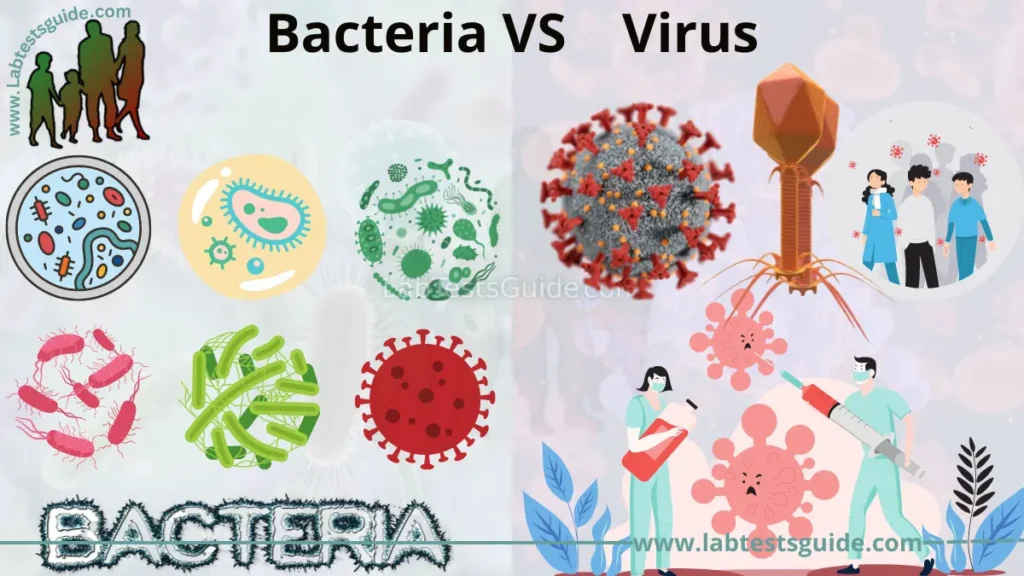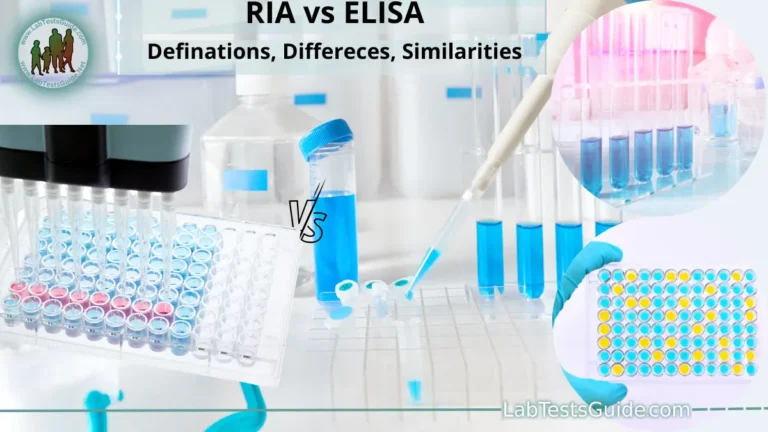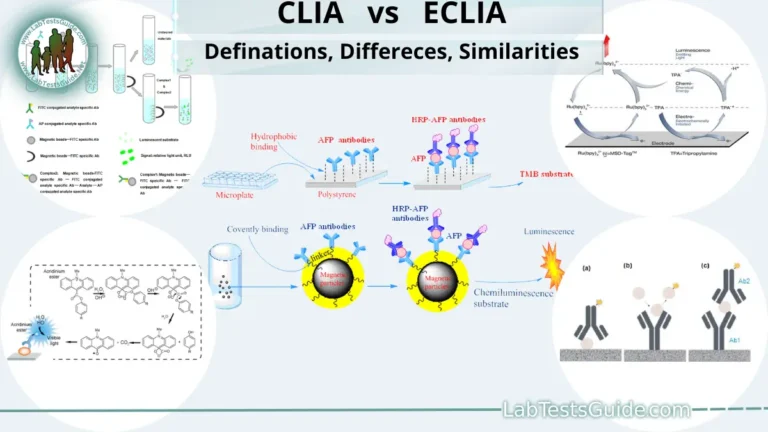Difference Between Bacteria and Virus. Bacteria are single-celled organisms that can exist independently, while viruses are non-living particles that require a host cell to replicate. Bacteria are typically larger and have more complex structures, while viruses are much smaller and simpler. Antibiotics are effective against bacteria but not viruses, and both can cause a range of illnesses and diseases in humans and animals.

Definations:
Bacteria Defination:
Virus Defination:
Differences Between Bacteria and Virus:
Bacteria and viruses are both microorganisms that can cause disease in humans and other living organisms, but they are quite different in their structure, behavior, and the way they interact with their hosts. Here are some key differences between bacteria and viruses:
Structure:
- Bacteria: Bacteria are single-celled organisms that are larger and more complex than viruses. They have a cell wall, cytoplasm, and genetic material (DNA or RNA) in a circular shape.
- Virus: Viruses, on the other hand, are much smaller than bacteria and are not even considered living organisms because they cannot replicate on their own. They consist of a protein coat called a capsid and genetic material (DNA or RNA) inside.
Reproduction:
- Bacteria: Bacteria reproduce by dividing into two identical daughter cells through a process called binary fission. They can also exchange genetic material through a process called conjugation, which allows them to adapt to different environments and acquire resistance to antibiotics.
- Virus: Viruses cannot replicate on their own and need to invade a host cell to multiply. Once inside, they take over the host cell’s machinery to produce new viruses, which eventually burst out of the host cell and infect other cells.
Treatment:
- Bacteria: Bacterial infections can be treated with antibiotics, which target specific structures or processes in bacteria that are not present in human cells. However, antibiotics are ineffective against viral infections
- Virus: viruses do not have the same structures or processes as bacteria. Antiviral drugs can be used to treat some viral infections, but they are often less effective than antibiotics and may have more side effects.
Symptoms:
- Bacteria: Bacterial infections can cause a wide range of symptoms, depending on the type of bacteria and the location of the infection. Common symptoms include fever, pain, swelling, and inflammation.
- Virus: Viral infections also have a wide range of symptoms, but they often cause more systemic symptoms such as fever, fatigue, and muscle aches.
Prevention:
- Bacteria: Bacterial infections can be prevented by practicing good hygiene, such as washing hands frequently and avoiding close contact with people who are sick. Vaccines are also available for many bacterial infections, such as tetanus, diphtheria, and pertussis.
- Virus: Viral infections can also be prevented by practicing good hygiene, but vaccines are only available for a limited number of viruses, such as influenza, measles, and HPV.
Overall, while bacteria and viruses share some similarities, they are quite different in their structure, behavior, and the way they interact with their hosts. Understanding these differences can help in the diagnosis and treatment of infections caused by these microorganisms.
Table of Differences:
Here is a table summarizing the key differences between bacteria and viruses:
| Feature | Bacteria | Virus |
|---|---|---|
| Size | Larger (0.5 to 5 micrometers) | Smaller (0.02 to 0.3 micrometers) |
| Structure | Single-celled organism with a cell wall, cytoplasm, and genetic material (DNA or RNA) in a circular shape | Non-living particle with a protein coat (capsid) and genetic material (DNA or RNA) inside |
| Reproduction | Reproduces by binary fission or conjugation | Reproduces by invading a host cell and taking over its machinery to produce new viruses |
| Treatment | Antibiotics can be effective against bacterial infections | Antiviral drugs can be used to treat some viral infections, but they are often less effective than antibiotics |
| Symptoms | Can cause a wide range of symptoms, depending on the type and location of the infection | Can cause systemic symptoms such as fever, fatigue, and muscle aches |
| Prevention | Good hygiene and vaccines are available for many bacterial infections | Good hygiene and vaccines are only available for a limited number of viral infections |
| Examples | Streptococcus, E. coli, Salmonella | Influenza, HIV, herpes, Zika |
It’s worth noting that while this table provides a general overview of the differences between bacteria and viruses, there are exceptions and variations within each category. For example, some bacteria are naturally resistant to certain antibiotics, and some viruses can integrate their genetic material into the host cell’s genome, allowing them to persist for long periods of time.
Basic Function of Bacteria:
Bacteria are single-celled organisms that are found in virtually every environment on Earth. While some types of bacteria can cause disease, most bacteria are beneficial or even essential to life. Here are some of the basic functions of bacteria:
- Decomposition: Bacteria play a vital role in breaking down organic matter and recycling nutrients back into the ecosystem. They can decompose dead plants and animals, as well as other organic material like sewage and waste.
- Nitrogen fixation: Some bacteria are capable of converting atmospheric nitrogen into a form that can be used by plants and other organisms. This process, known as nitrogen fixation, is essential for the growth and development of many types of plants.
- Food production: Bacteria are used in the production of a wide range of foods, including cheese, yogurt, sauerkraut, and pickles. They can also be used to ferment beer, wine, and other alcoholic beverages.
- Bioremediation: Bacteria can be used to clean up environmental pollution caused by oil spills, chemical spills, and other types of contamination. They can break down pollutants into less harmful substances through a process called bioremediation.
- Symbiosis: Many types of bacteria live in symbiosis with other organisms, including humans. For example, bacteria in the human gut help to digest food, produce vitamins, and prevent the growth of harmful bacteria.
- Disease: While many bacteria are beneficial or harmless, some types of bacteria can cause disease in humans and other animals. These bacteria can cause a wide range of illnesses, from mild infections like strep throat to more serious conditions like pneumonia and sepsis.
Overall, bacteria play a crucial role in the ecosystem and in the lives of humans and other organisms. While some types of bacteria can be harmful, most are beneficial or even essential to life.
Basic Functions of Virus:
Viruses are very different from bacteria and other living organisms, and they have a limited set of functions due to their unique structure and mode of replication. Here are some of the basic functions of viruses:
- Replication: The primary function of a virus is to replicate and produce new viral particles. Viruses invade host cells and use the host’s cellular machinery to produce copies of the virus.
- Infection: Viruses can infect and replicate in a wide range of host organisms, including humans, animals, plants, and bacteria. Different types of viruses can cause a wide range of diseases, from the common cold to more severe illnesses like HIV/AIDS and Ebola.
- Mutation: Viruses are prone to mutation and can rapidly evolve to adapt to new hosts or environments. This can make it difficult to develop vaccines or antiviral drugs that are effective against all strains of a virus.
- Transmission: Viruses can be transmitted from person to person through a variety of routes, including respiratory droplets, contact with bodily fluids, or ingestion of contaminated food or water.
- Persistence: Some types of viruses can persist in the body for long periods of time, even after symptoms have resolved. This can lead to chronic infections or long-term health complications.
Overall, the basic function of a virus is to invade host cells and produce new viral particles, often leading to disease and transmission to new hosts. While viruses are not considered living organisms, they can have a significant impact on the health and well-being of humans and other organisms.
Similarities Between Bacteria and Virus:
Bacteria and viruses are both microorganisms that can cause disease, but there are also some similarities between them:
- Both can cause disease: Both bacteria and viruses can cause diseases in humans and other animals. Some infections are mild, while others can be severe or even life-threatening.
- Both can be spread through contact: Both bacteria and viruses can be spread through direct contact with an infected person, as well as through contaminated objects, food, or water.
- Both can be prevented through good hygiene: Good hygiene practices, such as frequent hand washing and avoiding close contact with sick individuals, can help prevent the spread of both bacterial and viral infections.
- Both can be treated with medication: While antibiotics are generally effective against bacterial infections, there are also antiviral medications that can be used to treat some viral infections.
- Both can develop resistance to treatment: Overuse or misuse of antibiotics and antivirals can lead to the development of drug-resistant strains of bacteria and viruses, making it more difficult to treat infections.
- Both can have beneficial roles: While some bacteria and viruses can cause disease, many others are beneficial or essential to life. For example, bacteria in the gut help with digestion, and some viruses can be used in gene therapy to treat genetic disorders.
Overall, while bacteria and viruses have some important differences, they also share some similarities in terms of their ability to cause disease, transmission, prevention, and treatment.
Table of Similarities:
Here is a table summarizing the similarities between bacteria and viruses:
| Bacteria | Viruses | |
|---|---|---|
| Cause | Can cause disease | Can cause disease |
| Transmission | Can be spread through contact | Can be spread through contact |
| Prevention | Good hygiene can help prevent | Good hygiene can help prevent |
| Treatment | Can be treated with antibiotics | Can be treated with antivirals |
| Resistance | Can develop resistance to drugs | Can develop resistance to drugs |
| Beneficial | Some types are beneficial | Some types can be used in therapy |
Note that there are also important differences between bacteria and viruses, which have been discussed in previous responses.
FAQs (frequently asked questions ):
What is the difference between bacteria and virus?
A: Bacteria are single-celled organisms that can live independently, while viruses are non-living particles that require a host cell to replicate.
Are bacteria or viruses more dangerous?
A: Both can cause diseases, but the severity of the illness depends on the type of bacteria or virus involved.
How do bacteria and viruses differ in terms of structure?
A: Bacteria are larger and have a more complex structure than viruses, which are much smaller and simpler.
Can antibiotics treat viruses?
A: No, antibiotics are only effective against bacterial infections and cannot treat viral infections.
What are some examples of bacterial infections?
A: Some examples of bacterial infections include strep throat, urinary tract infections, and pneumonia.
What are some examples of viral infections?
A: Some examples of viral infections include the common cold, flu, and HIV/AIDS.
How do bacteria and viruses spread?
A: Bacteria and viruses can spread through direct contact with infected individuals, as well as through contaminated objects, food, or water.
How long do bacterial and viral infections last?
A: The duration of an infection depends on the type of bacteria or virus involved and the severity of the illness.
Can you develop immunity to bacterial and viral infections?
A: Yes, the immune system can develop immunity to both bacterial and viral infections, but the mechanisms of immunity differ between the two.
What are some common symptoms of bacterial infections?
A: Common symptoms of bacterial infections include fever, chills, fatigue, and inflammation.
What are some common symptoms of viral infections?
A: Common symptoms of viral infections include fever, cough, sore throat, and body aches.
How can you prevent bacterial and viral infections?
A: Good hygiene practices, such as frequent hand washing and avoiding close contact with sick individuals, can help prevent the spread of both bacterial and viral infections.
What is the incubation period for bacterial and viral infections?
A: The incubation period for bacterial and viral infections can vary depending on the type of infection and the individual’s immune response.
How do bacterial and viral infections affect the body?
A: Both bacterial and viral infections can cause damage to the body’s tissues and organs, leading to a wide range of symptoms and health complications.
Can bacteria and viruses cause the same symptoms?
A: Yes, some bacterial and viral infections can cause similar symptoms, making it difficult to distinguish between the two without laboratory testing.
What are some complications of bacterial and viral infections?
A: Complications of bacterial and viral infections can include organ failure, sepsis, and death in severe cases.
Can bacterial and viral infections be transmitted from animals to humans?
A: Yes, some bacterial and viral infections can be transmitted from animals to humans, such as Lyme disease and bird flu.
Can bacterial and viral infections be treated with natural remedies?
A: Some natural remedies may be helpful in alleviating symptoms, but they cannot cure bacterial or viral infections.
Can bacteria and viruses mutate?
A: Yes, both bacteria and viruses can mutate, leading to the development of drug-resistant strains and new variations of the infection.
How do vaccines work against bacterial and viral infections?
A: Vaccines can stimulate the immune system to produce antibodies against specific bacteria or viruses, providing protection against future infections.
Conclusion:
In conclusion, bacteria and viruses are both microorganisms that can cause disease in humans and animals. However, they differ in their structure, replication mechanisms, and response to antibiotics and antivirals. Understanding the differences between bacteria and viruses is important in the prevention, diagnosis, and treatment of infectious diseases. By practicing good hygiene habits and seeking medical attention when necessary, individuals can reduce their risk of contracting bacterial and viral infections and minimize the spread of these diseases.
Possible References Used





